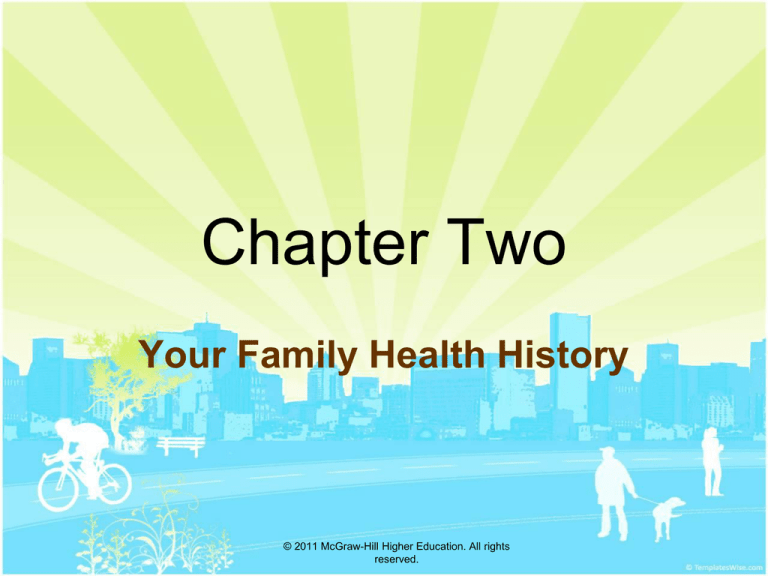
Chapter Two
Your Family Health History
© 2011 McGraw-Hill Higher Education. All rights
reserved.
Creating a Family Health
Tree
• Also called a genogram or
genetic pedigree
• Visual representation of your
family’s genetic history
• Illustrates the patterns of health
and illness within a family
• Pinpoints areas of special
concern or risk for you
2
Sample Family Health Tree
3
What can you learn from
your family health tree?
• An early onset of disease is more likely to
have a genetic component
• The appearance of a disease in multiple
individuals on
the same side
of the family
is more
likely to
have a
genetic
correlation
4
What else can you learn from
your family health tree?
• A family member with multiple cancers
represents a greater likelihood of a
genetic association
• The presence of disease in family
members who have good health habits
is more suggestive of a genetic cause
than is disease in members with poor
health habits
5
You and Your Genes:
The Basics of Heredity
• The nucleus of every human cell contains an
entire set of genetic instructions stored in our
DNA (deoxyribonucleic acid)
• DNA has four building blocks that can be
arranged to form a distinct message (gene)
that acts as the body’s instruction booklet
• Within the cell’s nucleus, DNA is divided into
23 pairs of chromosomes (one set of each
pair comes from each parent)
6
Chromosomes, Genes, and
DNA
7
The Human Genome
Project
• Launched in 1990
• An international collaboration
between 20 groups in 6 countries
• In April 2003, it was announced
that the sequencing of the human
genome was complete
8
The Human Genome Project
Discoveries
• Humans have only 20,000 to 25,000
genes (same as a mouse)
• Found many potential applications in
medicine and pharmaceuticals
• Helped confirm that race has more to do
with social and cultural interactions and
has no biological basis
9
The Role of Mutations
• A change in a gene is called a
mutation
• Alternate forms of the same gene
are called alleles
• Some mutations are harmful, other
mutations can be beneficial, and
some have no effect
• Mutations allow for human
diversity
10
Genetic
Inheritance
• Alternate forms of
genes, called alleles,
are responsible for
traits such as eye color
• Alleles can be dominant or recessive
• Most characteristics (such as height or skin
color) are determined by the interaction of
multiple genes at multiple sites of different
chromosomes
11
Single-Gene Disorders
• Some diseases are caused by the
alteration (mutation) of a single gene
• Autosomal dominant disorder: Mutated
gene is on a dominant autosome
• Autosomal recessive disorder: Two
copies of a mutated gene on an
autosome
• Sex-linked disorder: Mutated gene is on
the sex chromosome
12
Multifactorial Disorders
• Many diseases and traits can
result from interactions between
genes and the external
environment
• Account for the majority of
illnesses and death in the
developed world
• Heart disease is one example of a
multifactorial disease
13
Multifactorial Inheritance in
Personality and Behavior
• Genes appear to play a role in
personality and everyday
behavior
• Differing personality traits, sexual
orientations, and inclination
towards addiction may be caused
by genetic differences
14
Chromosomal Disorders
• An inherited disorder caused by the addition,
loss, or alteration of an entire chromosome
• May lead to fetal death or death within the first
year of life
• Individuals may exhibit a broad range of
symptoms, called a syndrome, ranging from
characteristic physical traits to developmental
delays to growth abnormalities
• Down Syndrome is an example of such a
disorder
15
Genetic Counseling and
Testing
•
•
Genetic counseling helps individuals and
families understand genetics, evaluate
risks, learn about diagnostic tests, and
discuss treatment options
Popular tests include:
–
–
–
–
–
Diagnostic
Predictive
Carrier
Prenatal Screening
Newborn Screening
16
Management and Treatment
of Genetic Conditions
Treatments may include:
• Dietary Modification
• Medication
• Environmental Adaptation
• Gene Therapy
17
Implications of Genetic
Research
• Controversial issues in genetic
screening and testing
• Issues of privacy and
discrimination
• Workplace discrimination
• Health insurance discrimination
• Eugenics (selective breeding)
18










